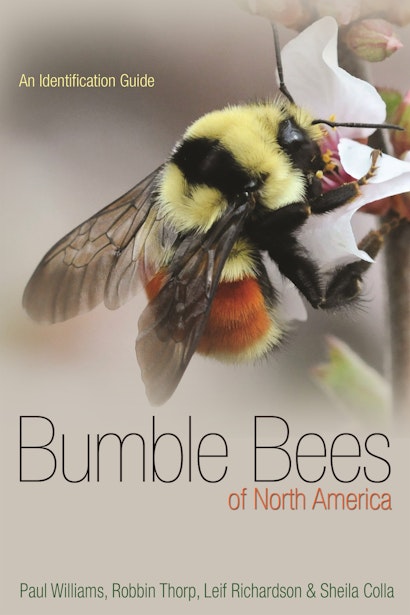More than ever before, there is widespread interest in studying bumble bees and the critical role they play in our ecosystems. Bumble Bees of North America is the first comprehensive guide to North American bumble bees to be published in more than a century. Richly illustrated with color photographs, diagrams, range maps, and graphs of seasonal activity patterns, this guide allows amateur and professional naturalists to identify all 46 bumble bee species found north of Mexico and to understand their ecology and changing geographic distributions.
The book draws on the latest molecular research, shows the enormous color variation within species, and guides readers through the many confusing convergences between species. It draws on a large repository of data from museum collections and presents state-of-the-art results on evolutionary relationships, distributions, and ecological roles. Illustrated keys allow identification of color morphs and social castes.
A landmark publication, Bumble Bees of North America sets the standard for guides and the study of these important insects.
- The best guide yet to the 46 recognized bumble bee species in North America north of Mexico
- Up-to-date taxonomy includes previously unpublished results
- Detailed distribution maps
- Extensive keys identify the many color patterns of species
Awards and Recognition
- Winner of a 2015 Outstanding Reference Sources Award, Reference and User Services Association, American Library Association
"A very helpful guide for any one interested in bumble bees."—Amanda Williams, buzzaboutbees.net
"As bee populations plummet and environmental concerns continue to make the news, there is widespread interest in bees. This attractively priced guide helps users identify the 46 species found north of Mexico and offers insight into their ecology and habitats. . . . This guide will be useful in public and academic libraries where there is an interest in bees or the environment."—Rebecca Vnuk, Booklist
"Identif[ies] the 46 species of bumblebee that are found in North America (Mexico is not included), far more than previous guides. The introduction presents clear information on these bees generally, their distribution, colony cycle, and interactions with plants. . . . An attractive, worthwhile purchase."—Margaret Heilbrun, Library Journal
"Because of their importance as a pollinator, their ubiquity (in various species, of course) across the continent, and simply because the lives and behaviors bumble bees are so fascinating, Bumble Bees of North America should be considered as a must-read by all amateur naturalists. Professionals—be they entomologists, ecologists, general biologists, and most especially teachers of life science subjects at all levels—would also do well to add it to their reading lists for both its superb introduction to the genus as well as its value as a reference guide."—John Riutta, Well-read Naturalist
"The timely arrival of Bumble Bees of North America on bookstore shelves is as welcome as its namesake insects are in gardens. . . . Given that the last comprehensive guide to North American bumble bees was published in 1913, Williams, Thorps, Richardson, and Colla's Bumble Bees of North America offers a much?needed review of the status and identification of the 46 bumble bee species north of Mexico. . . . [A] much?needed milestone in the ability of scientists and citizens alike to sort bee species found afield and at home. With bees on the decline, the ability to identify and inventory the buzz in our backyards may prove critical in future conservation efforts."—Matthew Bettelheim, (bio)accumulation
"[T]his book [is] a useful addition to any gardener or wildlife watcher's library. The really nice thing about this guide is the number and quality of the photographs they provide: I really need to get a copy of this book to help me identify the bumble bees I catch in my surveys."—AC, Wildlife Activist
"Accessible to both the layman and serious apiologist. Carefully organized, it begins with an introduction that is a must-read before moving on to the comprehensive bumble bee ID guide. . . . I commend this book to all lovers of native plants."—Harold Smith, Blazing Star
"This reasonably priced, attractive volume with excellent photographs and color plates will be valuable to professionals as well as anyone interested in identifying or learning more about bumblebees."—Choice
"I encourage all melittologists to obtain a copy for ready use, as well as anyone interested in the conservation, ecology, biology, natural history, or simple appreciation of bumble bees."—Michael S. Engel, Entomologist's Monthly
"[A] most desirable book. Each species is beautifully photographed and then described in detail, with maps and identification markings as well as comprehensive text to inform you about the particular bee in question."—Mary Montaut, An Beachaire
"This is a very well-written book which presents and updates information from a wide range of sources in a very readable and clear way."—Mike Edwards, Journal of the British Entomology and Natural History Society
"Bumble Bees of North America has not only provided casual observers and professionals with a comprehensive treatment of North American bumblebees, it has delivered utility while preserving aesthetics."—Samuel O'Dell, Prairie Naturalist
"This book is primarily an identification manual that also describes the distribution of the species. It is the perfect size for a field guide but it may be even more helpful when you are using microscopic characteristics for identification. The Bumble Bees of North America is also an invaluable reference for those of us who want to learn about and identify which bumble bees are our neighbours."—Tracy Ferreira, Bulletin of the Entomological Society of Canada
"I enjoyed Bumble Bees of North America and learned new things that will be useful in my work. This is a lovely book."—Sam Droege, USGS Patuxent Wildlife Research Center
"A better team of scientists couldn't have written this amazing new book on bumble bees. Filled with diverse content, it will be popular with its broad audience. Readers will want to get out and find bumble bees, observe them, and learn what they can do to conserve them."—Stephen L. Buchmann, University of Arizona

